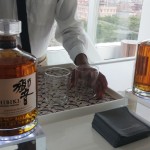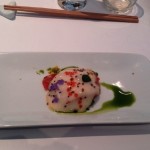Photos, Notes & Review: Hibiki Japanese Harmony Whisky Unveiled in NYC
Suntory Whisky hosted a launch party for the new Hibiki Japanese Harmony expression on June 30th in New York City. The event, held at The New Museum, included a whisky tasting led by Suntory’s 4th Chief Blender, Shinji Fukuyo, and a paired menu crafted by chefs Isao Yamada and David Bouley.
Fukuyo-san gave a short presentation on Suntory and Hibiki, leading to a tasting flight based on five of the different component whiskies which go into the Japanese Harmony blend. Japanese Harmony is a NAS, or No Age Statement, whisky, and Fukuyo-san mentioned the challenge of creating the right flavor profile without the aid of lengthier aging, instead focusing more on the nuances of blending.
That’s right at home with Japanese whisky as a whole of course. For instance, from my Beginner’s Guide to Whisk[e]y, I noted:
“[I]n Japan, it’s not unusual for a distillery to produce a very broad range of styles, utilizing different stills, mash bills and profiles, all going to the brand’s own blend. More often than not, the result is a light but deceptively nuanced whisky.”
Japanese Harmony Details & Tasting
Japanese Harmony is a blend of at least 10 malt and grain whiskies, aged in five different casks, hailing from Suntory’s Yamazaki, Hakushu and Chita distilleries. It utilizes many of the same key whiskies from the original Hibiki blend.
The largest volume contributor in the blend is a young grain whisky from the Chita distillery. It provides fruity and floral notes, and gave the Japanese Harmony a creamy mouthfeel.
A malt whisky aged in American white oak was referenced by Fukuyo-san as the backbone of Japanese Harmony, and “the solid base of Hibiki whisky.” Next came a sherry cask aged malt whisky and a Mizunara (Japanese oak) aged malt whisky, both referenced as “dressing elements”, designed to provide specific flavor notes to the blend. With the former, it’s the rich sweetness, dark fruits, and coffee and espresso notes of the sherry, and with the latter, it’s the “distinctive Japanese” long, spicy aftertaste.
Finally came a smoky malt whisky, and if you hadn’t been told otherwise, you’d be forgiven if you thought it was Ardbeg 10 in the glass. This is known as “the hidden player” of the blend and used in small amounts. After moving through this series of whiskies, it was time to try the finished product itself, Hibiki Japanese Harmony…
Very smooth and light, dominated by floral notes. I felt the sherry aged whisky provided a good deal of the flavor on the palate, with the grain whisky providing the nose and the mouthfeel, the Mizunara aged whisky kicking in with that spicy, oaky aftertaste. [For my full tasting notes, see the full review on Distiller, to come shortly].
After the tasting, chef Bouley spoke at length about how to pair whisky with food, and the different components on the plate and in the glass to tie together. Guests were able to sample the Japanese Harmony in a high ball, on the rocks, and neat, at different stages of the meal.
The menu began earlier in the evening with two passed bites as guests arrived. These included blue shrimp with Hibiki and green tea leaf served on a soba chip, and a Washu beef shabu-shabu onigiri.
The appetizer for the sit down meal was a smoked salmon dish with asparagus and fennel, topped with lemon foam and trout caviar, all presented in a wonderfully artistic fashion. This was followed by an entree of lamb, perfectly prepared to be juicy and tender, with satoimo puree, drizzled with a Hibiki and red wine garlic sauce. Desserts included a matcha cake, and a chocolate and hazelnut dacquoise, along with a last-minute Hibiki ice cream dessert which chef Bouley threw into the mix, playing on a favorite recipe from his restaurants.
Keep an eye out for Hibiki Japanese Harmony on the shelf within the next 2-3 weeks, priced at $64.99.









Trackbacks/Pingbacks